- Chris Ramsey's Biography -
My identical twin brother, David, and I were born in 1962, and, having lived in New York City, Kentucky, Utah, Italy, and California, I have settled back into a comfortable life in Kentucky. My wife, Kathy, and I have two boys, Logan and Jonathan who both attend the University of Kentucky.
 |
Logan, Jonathan, Kathy, Chris Ramsey |
I have always been interested in objects that are hand-made and have been drawn to pieces created from wood. I began turning in 1992 when my brother, David, showed up at my home with a Delta lathe as a birthday gift. I had recently moved from California to Kentucky and was living on a houseboat on Lake Cumberland while remodeling a home I had purchased.
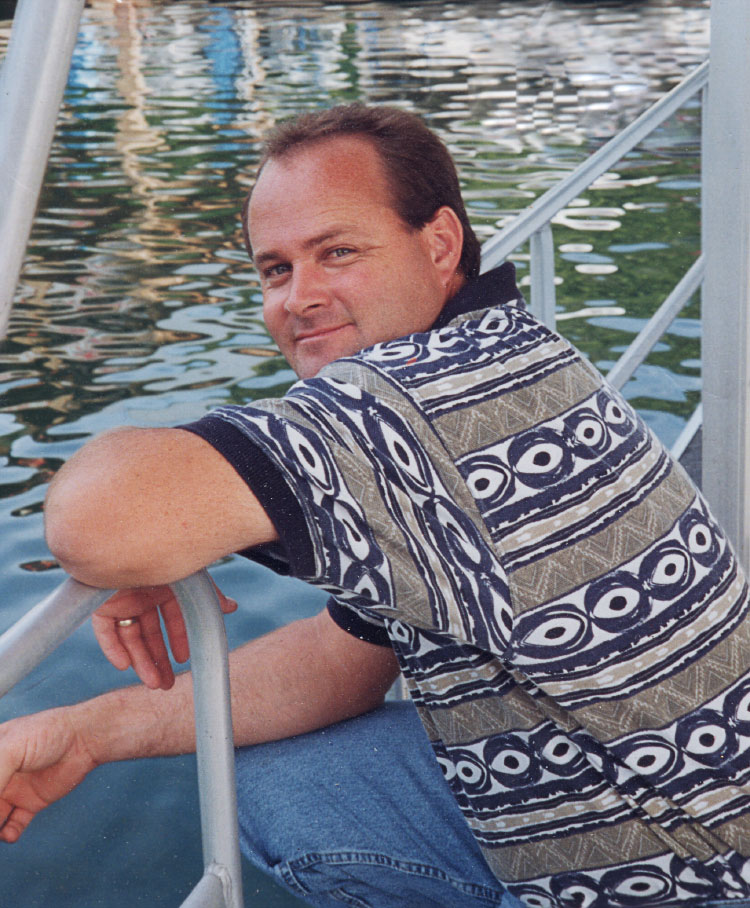
When winter set in, I began spending a lot of time learning how to turn. David showed me what he knew about woodturning and got me started on this wonderful journey. At the time, I was the owner of American Network Cable, a fiber optic/communications company. The hours I worked were, for the most part, late nights, after hours, and weekends which allowed me a lot of time to turn during the day. I found turning hollow forms to be the most challenging and made a practice of giving away most of the pieces I turned. I had been working in Louisville, KY, and had worked through the night to finish a large installation and was on my way home. At a stoplight, I saw a woodworking store with a lathe in the front window. I pulled in to check out the store, see the tools and inquire about the big lathe in the window. The manager and I began discussing woodturning as he showed me one of the pieces that he had turned. He said that he would like to see one of my pieces and, I just happened to have a small maple burl hollow form out in the truck. I brought the piece in and handed it to him. He looked at it for about three minutes then asked if I would be interested in selling the piece. He called a friend of his who was an art collector and within 15 minutes the collector arrived. While the two of them checked out my hollow form, I was checking out the new gouges. The manager motioned me over and the collector immediately offered me $800.00 cash for the piece. I thought he was yanking my chain until he handed me 8 Benjamin’s then asked for the first right of refusal on any future pieces I made. That was the first sale of a piece I had made. It was also the first piece of mine in his collection but not the last.
One of the most significant influences in my work was Rude Osolnik (1915-2001). I had visited an art gallery in Berea, KY, and saw a beautiful closed-form natural edge bowl made from oak burl that Rude had turned. Rude was a true master woodturner and was considered to be the grandfather of woodturning in America. A few months later I had the pleasure of meeting Rude at his home and studio called Poverty Ridge which was located in the mountains of the central part of Kentucky. Rude and I became good friends and we spent numerous hours in his studio where he taught me what tools to use for a specific application, tool control, the subtleties of form, shape, and design. Rude was a great woodturner, a great mentor, and, above all, a great person. A few years later I took a two-day workshop with JoHannes Michelsen turning cowboy hats. In the short time spent with JoHannes, I had a greater understanding of the bending properties of green wood and imagined the possibilities of what could be achieved.
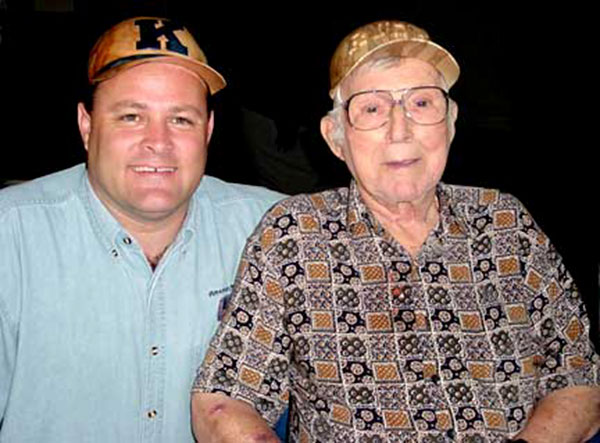 |
|
Chris with Rude Olsolnik |
After turning for a few years, I realized one of the biggest mistakes I was making was not challenging myself with more difficult shapes, designs, and concepts. I wasn’t thinking outside the box. I would bounce some of my ideas off of other more experienced turners and had been told that some of my ideas were impossible to create. After gaining more turning experience, I realized that some of the ideas I had thought of just might be doable. How do you know if you have not tried? It is important to always keep an experimental piece in process. If you run into a problem and can’t figure it out, set it aside, think of a solution to the problem, and, no matter what, don’t give up! In most cases, you will find a solution, and become successful with a piece that had challenged you.
Turning and carving are a continued evolution, however, it is not for everyone. I certainly understand and respect the purest point of view. That being said, there is only so far you can take the purist turned piece that is without carvings, dyes, pyrography, or any other added embellishments. I look back on the first pieces I had turned and carved. The early pieces were misshaped with a few mistakes and the carvings were much more basic. With the advancement of improved tool designs and the added amount of time and experience spent carving, what once was a difficult task had become much easier. The combination of turning and carving adds another element to the final product that can elevate the piece both in degree of difficulty and aesthetics. When you incorporate the bending of the turned and carved piece (as it dries) it can completely change the final product into a shape that would be impossible to turn and one that is so unique that collectors would fight over. I have focused most of my carving on structurally incorporated elements of the turned piece including legs, feet, and other support objects. I often challenge myself on a natural edge closed form with an extreme closed in rim and legs up to 14 inches to see how far I can take the legs. I would like to see my personal development broaden in carving surface enhancements and other carved embellishments. I have a few ideas!
To date, I have never given up on a turned and carved project. I do have two projects currently on “hold” as I try to figure out how to complete the next few steps in the process of each piece. The rewards are huge when you figure out the “how-to” and bring a difficult concept to fruition.
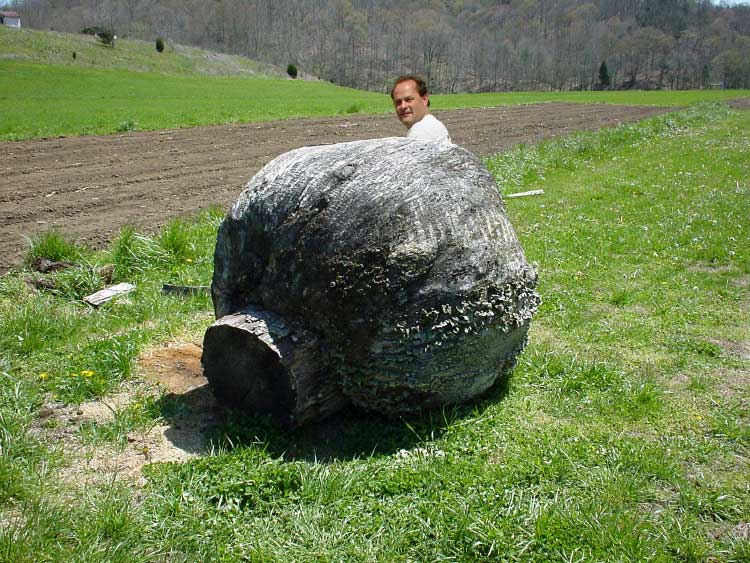
Chris with a BIG Burl
If you are having trouble trying to figure out the next step on a project, talk to other woodturners and bounce your ideas off of each other. Two minds are better than one. Talk to members of your woodturning club and don’t give up. Take the good advice and throw out the bad advice. The completion of a piece that took months or even years to figure out and was also labor-intensive is the ultimate reward. It will lead to greater challenges, greater sales, and greater opportunities.
To date, I have made 3,902 full-size wearable custom fit hats and 4,898 mini hats. When turning a hat, the shape that must be turned is pre-determined so that when it is bent and finished it looks like the hat that the customer ordered and that you intended to make. There really is no great exploration of shape and design in turning hats other than the different hat types and styles that can be turned. You will become proficient at duplicating shapes but there is zero out-of-the-box thinking allowed in the hat turning process. There is the possibility of an added surface embellishment element such as a carved logo, a design using pyrography, or a basket illusion design.
My favorite type of turning is anything with a natural edge that includes carving. Turning a large natural edge closed-form piece with carved legs is always very rewarding. Closing the flowing form of the rim inward to an extreme adds quite a challenge while hollowing with a bowl gouge. Unlike turning a hat, the shape and design of a turned and carved piece can be changed on the fly and any changes in size, shape, or design are welcomed. You allow yourself the opportunity to explore unlimited shapes, designs, leg styles, rim design, natural edge, manufactured rim, big and tall, or short and squatty forms. The mind is completely free to explore any and all possibilities to maximize creativity. The sky’s the limit!
In the future, I would like to see many more collaborative efforts between artists. My first two collaborative pieces were with my twin brother, David. The two pieces we collaborated on are entitled “Through the Arms of the Maker” and “A Walk in the Wood.” Both pieces were turned and carved from maple burl and were a lot of fun to make. I have collaborated with several other turners/carvers and have been very pleased with the final outcome of the pieces. A collaborative piece will also spark interests in new and different techniques, more creative ideas and introduce you to other tools that are used to achieve the final completed piece. The power of two minds applied to the creative process of a single piece has caught the attention of numerous collectors. I have had several commissioned collaborative piece requests from collectors. I have experienced a significant increase in the value/price of a turned and carved collaborative piece as well as a greater exposure to the work produced by each collaborating artist.
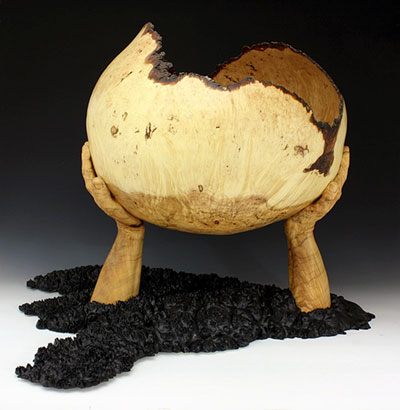 |
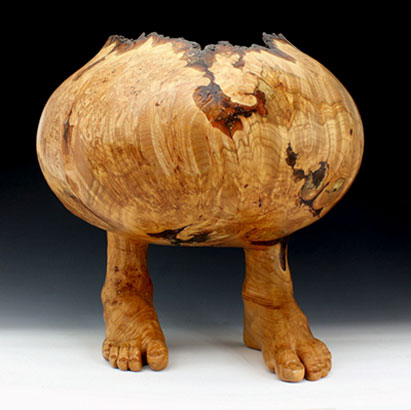 |
Through the Arms of the Maker |
A Walk in the Wood |
I believe the most positive aspect within the world of woodturning is the common bond we all share for the love of what we do. The life-long friendships I have made with turners from around the world are remarkable. We are unlike any other group in the open and free sharing of information of our medium which elevates the level of knowledge, skills, creativity, and artwork.
Woodturning has opened many doors and afforded me numerous opportunities. I have been fortunate to have taught and demonstrated throughout the United States and in several other countries. It was an honor to be invited to the White House by United States President George W. Bush for a ceremony in the Oval Office to present the President with a few pieces of my artwork.
I’m more than thankful that politics, religion, ethnicity, and other discriminatory elements are set aside and not a part of the make-up within the woodturning community. It is all about woodturning and everyone is invited to the party.
As far as my dislikes within the world of woodturning there is only one that I take issue with and that is the non-acceptance of copying. Copying is widely accepted in everything we have done since birth. Walking, talking, writing, singing, painting, and yes, copying is how we learn woodturning. The first piece I turned was a candlestick that I duplicated. The second piece I turned was a bowl that I tried to emulate, as were the next 30 bowls. I saw a beautiful hollow form made by Richard Raffan and my mind was blown. How did he do it? What tools did he use? I called him, bought his tools, his books, his videos, and tried to replicate his hollow form. My hollow form was not nearly as nice as his but eventually, I improved. We are all guilty of trying to replicate shapes, forms, and designs we find attractive. I liked Richard’s hollow form so much that I tried to recreate his masterful design. I went on to make several hundred hollow forms that were nothing like Richard’s, however, his work was my inspiration. I took what I had learned from Richard and put my own spin on it. I don’t own it, and nobody does. If you want to turn a hat, don’t ask if it is OK, just turn a hat! There is no license, and it is OK! After all, wooden hats have been turned on a lathe since the 1700s. If you are interested in learning how to turn a hat, or a three-legged bowl please go to www.turnedandcarved.com/plans for a detailed file that I have created that is filled with all the information, you will need to turn your own hat or a turned and carved three-legged natural edge bowl and it is 100% FREE!
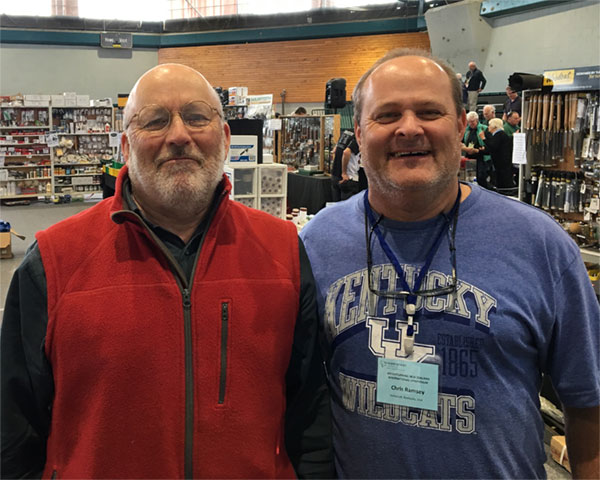 |
Richard Raffin and Chris |
My advice for other woodturners and carvers is, first and foremost, safety. Protect your eyes, ears, head, body, hands, and lungs. Use quality tools that are not overly dangerous. I absolutely avoid using any of the chainsaw disks that mount to a grinder. A good friend of mine nearly lost his life when one jumped out of his hands while he was carving. There are other carving disks you can use that work just as well that do not carry the risk factor of the chainsaw disk. Personally, I prefer the King Arthur Holy Galahad carving disks that allow you to see through the disk as you are carving. They are not grabby and are relatively safe. Make sure the piece you are carving is secure, be safe and take your time. Never carve when you are tired or fatigued and alcohol consumption can wait until you are finished carving for the day.
A helpful hint for carvers is to begin by practicing on a scrap piece of wood. Get to know the tool you are using, what the tool is capable of, and what the tool’s limits are. This will not happen in the blink of an eye. Become comfortable and confident in the tools you use before you dive into a project that requires carving. Above all, keep safety in mind, wear eye, hand, and respiratory protective gear and have a great time exploring the possibilities and improving your skills.
One other helpful tip is for removing metal stains in wood. When you find blue staining caused by a nail or some type of metal that was in a tree don’t throw the piece in the burn pile. Turn your piece, sand as usual then set the piece aside. There is a quick and easy solution to get rid of the staining. It is a cleaning powder called Bar Keepers Friend and can be purchased at Walmart or a home improvement store in the cleaning product aisle. It costs less than $3.00 for a 26 oz. container. Using rubber gloves, put some of the powder in a small container, add water and stir to make a slurry the consistency of runny toothpaste. Sand the metal-stained area with 220 grit then cover the stained area with the slurry mixture and let it dry for about 15 minutes. Wipe off the white mixture and your stain will be gone. For further details on removing rust stains, go to https://www.turnedandcarved.com/tips/stains.html. For further information on Bar Keepers Friend, go to www.barkeepersfriend.com.
Although I spend the majority of my time turning, some of the other hobbies I have are hiking, water and snow skiing, 4-wheeling, and boating. I also enjoy building highly figured and burl slab furniture. I’ve recently purchased a new bandsaw with a cut capacity of 70 inches wide by 30 feet long and have been cutting large burl slabs to build inventory stock. I like staying busy and when I’m out of the studio I spend my time enjoying my wonderful family and the great outdoors.